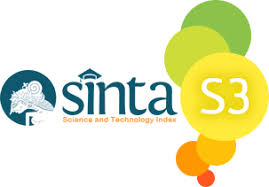Student’s communication privacy management on Facebook
 Abstract views: 218
,
Abstract views: 218
,
 PDF downloads: 152
PDF downloads: 152
Abstract
The purpose of this study was to describe the management of communication privacy of Facebook users. The research used the Theory of Communication Privacy Management . The research approach was quantitative with a survey method. Data collection was carried out using questionnaires distributed online via google.doc from 9-16 March 2020 to around 304 samples of Students of Universitas National who were active users of Facebook. The data were presented in a frequency distribution table and analysed by descriptive statistics. The result shows (1) most respondents were selective in publishing their personal data on Facebook. Only date of birth and religion were considered non- privacy; (2) In conveying certain information or messages through various features on Facebook, most of the respondents applied collective limitation, but still controlled the boundaries. It meant allowing others to view or read various posts, but limiting the active activities of others on their timeline; (3) female respondents expanded access restrictions more for others when they posted feelings of pleasure, happiness, upset, anger and satire. The development of access to privacy is caused by psychological factors and respondents' motivation. Overall, the results of the study indicate that there was a communication privacy management activity of respondents on their Facebook.
References
Arifin, C. 2019. Pengguna Sosial Media di Indonesia Keempat di Dunia. Diakses tanggal 12 Nopember 2021.
Creswell, J.W. 2014. Research Design: Qualitative and qualitative Approaches. Sage Publication, Inc
Devito, J. A. 2011. Komunikasi Antarmanusia; edisi Kelima.Jakarta: Karisma Publishing Group
Fauzan, R. 2019. Pengguna Facebook dan Instagram Di Indonesia Terbanyak Keempat Dunia. Diakses tanggal 12 Nopember 2021.
Griffin, EM. 2011. A first look at Communication Theory: 8th edition.. McGraw Hill
Krisdyahayu, M.R. 2018. Sejarah Internet dan Perkembangan Media Sosial di Indonesia, dari Friendster hingga Snapchat. Diakses tanggal 12 Nopember 2021.
Lee, J; O. Gillath dan A. Miller. 2019. Effects of self- and partner’s online disclosure on relationship intimacy and satisfaction. Plos.One Collection: Emerging Therapies in mental health
Kurniawan, A.P & N.U. Hanasat. 2017. Perbedaan Ekspresi Emosi pada Tingkat Generasi Suku Jawa di Yogyakarta. Jurnal Psikologi 34 (1): 1-17
Levontin, L & E.Y. Tov. 2017. Negative Self-Disclosure on the Web: The Role of Guilt Relief. Front. Psychol. 8:1068. doi: 10.3389/fpsyg.2017.01068
Littlejohn, S.W., K.Foss., J.G. Oetzel. 2017. Theories of Human Communication: 11th ed. Illinois: Waveland Press, Inc
Manggala, A. 2018. Dua Menteri Paparkan Hasil Pembangunan. Diakses tanggal 13 Nopember 2021.
Nasrullah, R. 2015. Media Sosial:Perspektif Komunikasi, Budaya dan
Sosioteknologi. Bandung: Ramaja Rosdakarya
Neuman, W. L. 2011. Social Research Methods: Qualitative and
Quantitative Approaches. Pearson Education, Inc
Nurhayati, E. 2016. Memahami Psikologis Perempuan: Integrasi & Intercomplementer Perspektif Psikologi dan Islam. Batusangkar International Conference: 245-258
Paramitha, N.K.P & Suarya, L.M.K.S (2018). Peran Komunikasi Interpersonal Dan Ekspresi Emosi Terhadap Kepuasan Perkawinan Pada Perempuan Di Usia Dewasa Madya. Jurnal Psikologi Udayana. (S.I) : 16-28
Pertiwi, W.N. 2019. Facebook Menjadi Medsos yang Paling Digemari di Indonesia. Diakses tanggal 12 Nopember
Prawitasari, J.E. 2016. Mengenal Emosi Melalui Komunikasi Non verbal. Buletin Psikologi
M-Saleh, H,M., Z. Kh. Abdul., and AA. Ameen. 2017. The Effect of Facebook on Academic Performance for Undergraduate Students at Charmo University. International Journal of computer and technology 16 (2): 7596–7602
Toker, S and M.H.Bartuary. 2019. What foresees college students’ tendency to use facebook for diverse educational purposes?. International Journal of Educational Technology in Higher Education 16 (9)
Weaver II, R.L. 1997. Understanding Interpersonal Communication (7th ed.). Harper Collins College Publishers
West, R dan L.H. Turner. 2008. Pengantar Teori Komunikasi: Analisis dan Aplikasi, Edisi Ke-3. Jakarta: PT. Salemba Humanika

Jurnal Komunikasi Profesional is licensed under a Creative Commons Attribution-ShareAlike 4.0 International License.
1. Proposed Policy for Journals That Offer Open Access
Authors who publish with this journal agree to the following terms:
- Authors retain copyright and grant the journal right of first publication with the work simultaneously licensed under a Creative Commons Attribution License that allows others to share the work with an acknowledgment of the work's authorship and initial publication in this journal.
- Authors are able to enter into separate, additional contractual arrangements for the non-exclusive distribution of the journal's published version of the work (e.g., post it to an institutional repository or publish it in a book), with an acknowledgement of its initial publication in this journal.
- Authors are permitted and encouraged to post their work online (e.g., in institutional repositories or on their website) prior to and during the submission process, as it can lead to productive exchanges, as well as earlier and greater citation of published work (See The Effect of Open Access).
2. Proposed Policy for Journals That Offer Delayed Open Access
Authors who publish with this journal agree to the following terms:
- Authors retain copyright and grant the journal right of first publication, with the work [SPECIFY PERIOD OF TIME] after publication simultaneously licensed under a Creative Commons Attribution License that allows others to share the work with an acknowledgement of the work's authorship and initial publication in this journal.
- Authors are able to enter into separate, additional contractual arrangements for the non-exclusive distribution of the journal's published version of the work (e.g., post it to an institutional repository or publish it in a book), with an acknowledgement of its initial publication in this journal.
- Authors are permitted and encouraged to post their work online (e.g., in institutional repositories or on their website) prior to and during the submission process, as it can lead to productive exchanges, as well as earlier and greater citation of published work (See The Effect of Open Access).


